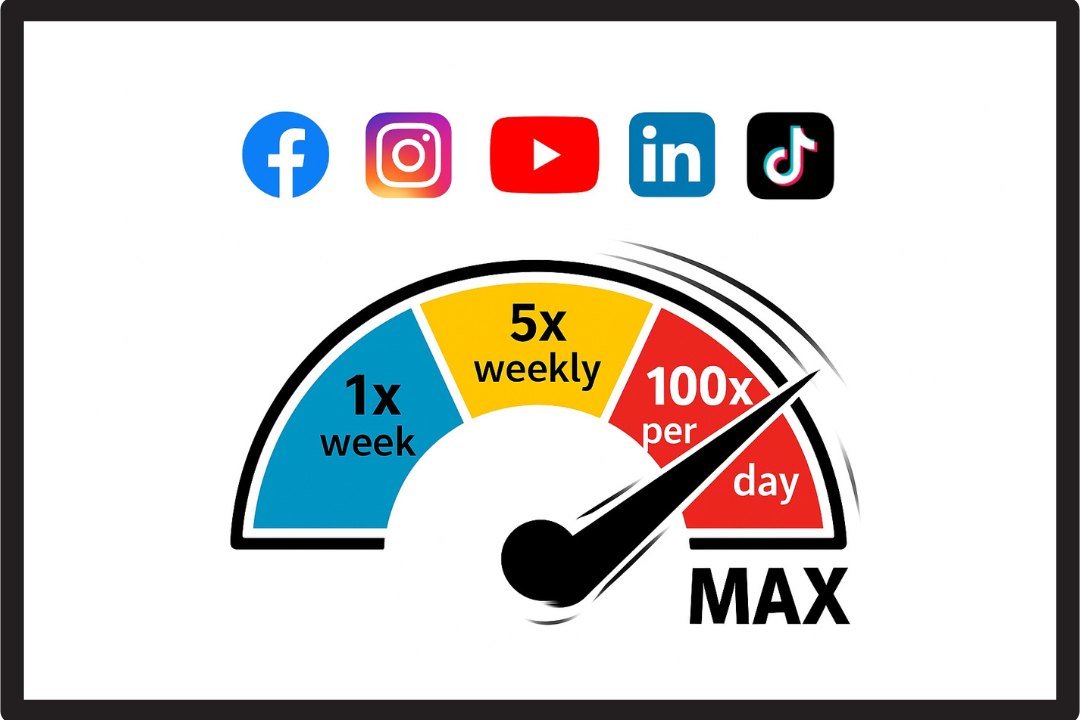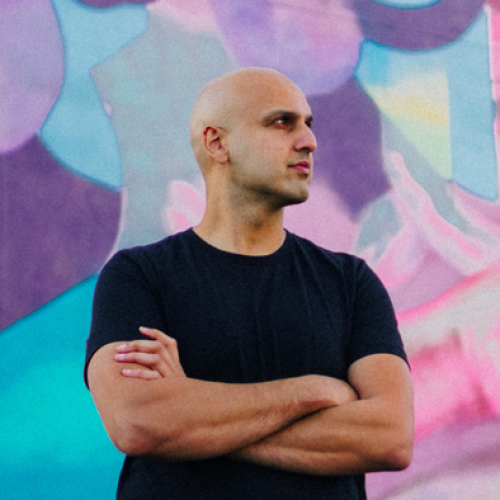I get this question almost every week from the experts I work with: “How often should I post on social media?”
Usually, they’re hoping I’ll give them a magic number. Post once a day. Three times a week. Twenty times a month. Something concrete they can put on their calendar and check off their to-do list.
But here’s what I’ve learned after working with dozens of subject matter experts who’ve built real authority (and business results) through social media: the experts who win aren’t obsessing over posting frequency. They’re focused on building something much more valuable — a recurring format that people actually look forward to.
The question isn’t “How often should I post on social media?” It’s “What kind of show format can I create that my audience will want to tune into?”
Key Points
- Consistency of format beats frequency of posting. A recognizable, repeatable “show” makes you memorable and positions you as the go-to authority.
- Your audience remembers you by your format, not your posting schedule. Predictable settings and style create mental shortcuts that boost recall and recommendations.
- Frequency is a tactical choice after format discovery. Post often during testing to find what works, then focus on sustaining quality and audience anticipation.
Why I Stopped Telling Clients to “Just Post More”
Early in my consulting career, I made the same mistake everyone makes. Clients would ask about posting frequency, and I’d say, “Well, more is generally better for the algorithm…”
Then I watched smart, accomplished experts burn out trying to fill arbitrary posting quotas with random content. A brilliant financial advisor posting motivational quotes because she needed to “hit her numbers.” A management consultant sharing industry news just to have something to publish.
They were posting more, but they weren’t building anything meaningful. Worse, all that random content was actually making them forgettable.
That’s when I realized something important: consistency in format matters way more than consistency in frequency.
The TV Show Revelation That Changed Everything
Think about your favorite TV show for a second. Let’s say it’s Friends (because honestly, it’s probably Friends).
Friends didn’t become a cultural phenomenon because it aired every single day. It became iconic because every Thursday night at 8 PM, you knew exactly what you were getting: six friends hanging out at Central Perk, dealing with dating and career stuff, making you laugh in a very specific way.
You didn’t tune in wondering “What random thing will happen tonight?” You tuned in because you loved that specific thing they did consistently.
Now here’s where it gets interesting for experts: Friends wasn’t just “six people in New York.” It was six people at Central Perk or their apartments with a very particular dynamic. The setting mattered. The format mattered. The consistency mattered.
That’s exactly what the best expert content creators do. They don’t just share expertise randomly — they create a recognizable show that people associate with their knowledge.
How NonToxicDad Became the Authority in Family Health
View this post on Instagram
Let me show you how this works in practice with one of my clients, NonToxicDad, a former geologist who became an expert in non-toxic living for families.
This guy is a former geologist who went through a lot of challenging health problems that he overcame which led him to becoming passionate about non-toxic living for families. When we started working together, he was trying to post on social media with health tips, sharing articles, and just throwing a bunch of stuff at the wall to see what sticks. It was essentially what most people do.
Then we developed what became his signature: “This is toxic”
So imagine NonToxicDad walking through Costco, picking up a popular family product, flipping it over, and explaining the ingredients like he’s your smart friend who actually knows what all those chemical names mean. Then he’d show you better alternatives right there in the same aisle.
Suddenly, he wasn’t just “another health expert.” He became “the guy who helps you shop healthier for your family.”
And here’s the brilliant part: just like Central Perk became iconic for Friends, his “stage” became instantly recognizable. Sometimes it was the grocery store aisle, sometimes it was his own kitchen, but the setting was always where real product decisions happened. When parents thought about making better choices for their family, they thought of him.
The results were dramatic. He went from struggling to get engagement to building a community of more than 1 million people and generating over 50 million monthly views across all his channels. More importantly, his business grew as new opportunities came in. He began doing brand deals with mattress companies, non-toxic underwear for men, and other health-focused brands. He launched a documentary series that promoted home testing kits, and drove customers to his own line of supplements . Over time, people began to see him as the go-to authority in his space.
Why Your Brain Loves Predictable Formats (And Your Audience Does Too)
Here’s something fascinating: our brains are pattern-recognition machines. When you create a consistent content format, you are not just making content easier for yourself, you are making it easier for people to remember, recall, and recommend you.
Neuroscience research shows that the brain relies on schemas. These are mental frameworks that help us quickly process and store information. When your content has a recognizable format, the audience’s brain can attach it to an existing schema, making it easier to retrieve later.
Think about how you describe your favorite experts or educators to friends:
- “You should follow this woman who does finance tips on TikTok.”
- “There’s this chef who recreates restaurant dishes at home.”
- “Check out this guy who explains tech stuff in simple terms.”
Notice the pattern? People describe experts by their format, not their posting frequency.
When someone talks about NonToxicDad, they do not say, “He posts three times a week.” They say, “the non-toxic guy”
That is positioning gold. Consistent formats create predictable mental shortcuts in your audience’s brain, which makes you easier to recommend, and easier to remember.
The Four Stages I’ve Seen Work (From Chaos to Authority)
After working with so many experts, I’ve noticed they all go through similar stages when they find their format:
- Stage 1: The Experiment You’re trying different things, seeing what sticks. This is messy and that’s okay. You might post 4-5 times a week just to test ideas quickly. Most of it won’t work, and that’s the point.
- Stage 2: The “Wait, That Worked” Moment. Something clicks. Maybe it’s a particular way you explain concepts, or a specific setting, or a unique angle. You get more engagement, people start asking for more of that thing.
- Stage 3: The Show You double down on what worked. You create a more structured version and commit to it. This is where the magic happens. You start to notice how people start recognizing your content before they even see your name.
- Stage 4: The Series Your format becomes part of your professional identity. You’re not just posting content anymore; you’re running a show that people anticipate. People visit your profile to watch more videos, and many click your link in bio to learn more about your products or services. Opportunities start to appear more naturally. Podcast hosts reach out for interviews. Brands see alignment and explore ways to collaborate. Other experts reference your work as an example of effective content in your field.
NonToxicDad is deep into Stage 4 now. His “This is Toxic” format has become so closely linked to his expertise that brands actively seek his endorsement, knowing it gives their products added credibility with consumers .
What Most Experts Who Create Content Get Wrong
Mistake #1: Trying to be everything to everyone I watch experts post about leadership on Monday, industry trends on Tuesday, personal development on Wednesday… By Friday, no one knows what they actually stand for.
Mistake #2: Copying formats that don’t fit A B2B consultant trying to recreate the “day in my life” content that works for lifestyle influencers. It feels forced because the audience doesn’t want that from them.
Mistake #3: Giving up too soon Here’s the thing about format development: it takes time for audiences to “get” what you’re doing. I’ve seen experts abandon winning approaches after just two weeks because they didn’t see immediate viral success.
Mistake #4: Obsessing over production quality Some of the most successful expert content I’ve seen was filmed on phones with natural lighting. Your audience cares about your insights, not your video quality.
Finding Your Format: The Questions That Actually Matter
Instead of asking “How often should I post?”, start asking these questions:
- What do people always come to me for advice about?
- What’s a setting or situation where my expertise naturally shows up?
- What misconception in my field drives me crazy?
- What process do I use that others find valuable?
For NonToxicDad, the answers were clear: Parents asked him about product safety, grocery stores were where decisions happened, he was frustrated by misleading health marketing, and he had a systematic way to evaluate products.
The “this is toxic” format hit all of these perfectly.
How Posting Frequency Actually Works
Once you have your format figured out, how often you post on social media becomes a tactical decision rather than an existential crisis.
During the testing phase, posting more often, ideally 5 to 7 times per week if you can sustain quality, simply gives you more chances at bat. Every post is an opportunity to try a different angle, test a new hook, and see how your audience responds. With a system in place for creating content, you can publish consistently, learn quickly, and spot patterns in what works.
It is not a hard-and-fast formula. The real goal is to keep innovating your brand and refining your message. More posts mean more feedback loops, which lead to faster improvement.
Once you find your winning format, you can dial in the schedule that works for you. For some experts, that’s 2 to 4 high-quality posts a week. For others, it is 5 to 7. The number matters less than your ability to maintain consistency, quality, and ongoing experimentation.
The Compound Effect That Most People Miss
Here’s what’s really exciting about this approach: format-based content compounds in a way that random posting never can.
Month 1-3: You’re figuring out your voice and refining your approach Month 4-6: People start recognizing your content style Month 7-12: You become known for your particular perspective Year 2+: Your format becomes synonymous with your expertise in that area
NonToxicDad didn’t become “the non-toxic guy” overnight. But 18 months later, he completely owns that space. When someone needs to make healthier choices while shopping with their family, they think of him first.
That’s not luck. That’s the power of consistent, format-driven content creation.
Where to Start (Without Overwhelming Yourself)
If you’re reading this thinking “Okay, but where do I actually begin?”, here’s what I’d recommend:
Spend the next week paying attention to the questions people ask you. Not just online, but in real life, in professional settings, in casual conversations. What do people consistently come to you for?
Then ask yourself: “Where does this expertise naturally show up in the real world?” For NonToxicDad, it was grocery stores. For a leadership expert I work with, it’s team meetings. For a financial advisor, it might be major life transitions.
Start there. Create 2-3 pieces of content in that setting or context. See what happens.
Don’t worry about being perfect. Don’t stress about posting frequency. Just focus on creating something valuable that you could realistically do again.
The Real Question You Should Be Asking
Instead of “How often should I post?”, try asking “What do I want to be known for, and what’s the most natural way to demonstrate that consistently?”
Because at the end of the day, social media for experts isn’t really about social media at all. It’s about building a reputation and demonstrating your expertise in a way that feels authentic and sustainable.
The posting frequency will sort itself out once you figure out what you’re actually trying to build.




